Chapter 7 Program
👉 Program the Vibe: all the parameters are easily controllable with the smart pickers and efficient powerful features.
This chapter deals with using the editor and the smart screen for fixture manipulation and parameter control.
Chapter index:
7.1 Parameters
Parameters are any feature of a device that may be manipulated and stored into an object.
Examples of parameters are:
Dimmer
Pan/Tilt
Cyan/Yellow/Magenta
Zoom/Focus
Gobo Wheel
Blade Rotation
To control properly any fixture, the Vibe device needs to be built according to the DMX chart of the fixture’s parameters, that is usually reported in the manufacturer’s user manual.
7.1.1 Param Banks
Vibe organizes the fixtures’ parameters under 6 standard Banks and 2 special Banks:
Standard Banks are:
Intensity
for params related to the power and rate of the light output
typical parameters are Dimmer, Shutter, Strobe
Position
for params related to the movement and focusing
typical parameters are Pan, Tilt, Move speed
Color
for params related to the light’s colors and tints
typical parameters are Red, Green, Blue, White, Cyan Magenta, Yellow, CTC
Beam
for params related to the angle and size of the light beam
typical parameters are Zoom, Focus, Iris, Prism
Image
for params related to the pictures that may be applied to the light beam
typical parameters are Gobo wheel, Gobo rotation, Animation wheel
Shape
for params related to the framing system that cuts the light output
typical parameters are Blade depth, Blade angle, Blade rotation
Special Banks are:
Control
a param that sends “real time” messages to fixtures control functions
typical functions are Lamp On, Lamp Off, Reset
it is a special bank because its parameters are not stored in cues, scenes and libraries
Media
a bank that collects specific features to control media servers
it is a special bank because its parameters are actually included in the standard banks
7.1.2 Virtual Params
Vibe automatically adds to the fixtures the relevant virtual parameters, that allow controlling the corresponding real parameters in a smart and effective way.
Virtual controls are also mapped to the 4 physical wheels.
Virtual parameters are the following:
Virtual Dimmer: assigned to fixtures that don’t have a specific dimmer parameter, usually RGB LEDs, it controls the light output intensity by adjusting the color values proportionally.
Virtual HSI: assigned to fixtures with any kind of color mixing system, it’s a set of 3 params (Hue, Saturation, Intensity) that controls the color output by adjusting the real color values.
👉 It comes particularly useful when a fixture needs to be switched with another having a completely different color mixing system, for example an CMY to an RGBA.
- Virtual XYZ: assigned to fixtures with Pan/Tilt parameters, it’s a set of 3 params (VX, VY, VZ) that controls the focusing by adjusting the position values. If based on a correct fixture calibration it allows to focus the fixtures on any stage point by simply tapping on the screen.
👉 It comes particularly useful when a fixture needs to be switched with another having a different Pan and Tilt range.
7.1.3 Fixture Manipulation
The manipulation of any fixture’s parameter values may be set by using either Vibe’s intuitive Smart Screen picker system or the conventional encoder wheels and the keypad method.
The switch between banks can be done either from the Smart Screen or through the combination SHIFT + # where the # represents the bank number.
Standard programming:
Programming may be done traditionally by using {Bank} keys and the 4 large push wheels.
Select the fixtures to program: Fixture # [+ ⟶ -]
Select the {BANK} of the parameter you wish to adjust.
Banks may contain more than 4 wheels of parameters. Tap the {BANK} key or push the encoder wheel again to page to the next set of 4 parameter wheels.
Select the Param to adjust either on the touch screen or by pushing the correspondent encoder wheel. The wheel display turns red.
Rotate the encoder wheel of the parameter you wish to adjust, or directly add values with the keypad:
- Push a parameter wheel to select the parameter
- AT will appear on the command line
- Type a value from Zero ⟶ Full.
@ is only used for the dimmer, parameters other than dimmer do not use the @ key.
A Parameter value must be entered in 2 digits or one digit and the [Enter] key for whole numbers: 05, 50, 5 [ENTER] = 50.
Interactive programming:
Programming may be done interactively by using {Bank} keys and the 4 large push wheels.
Select the fixtures to program: Fixture # [+ ⟶ -]
Select the {BANK} of the parameter you wish to adjust OR Drag the Wheel Picker on the right side of the Smart Screen and browse to the wheel and slot you want to program.
Tap the tab of the feature OR Tap the wheel slot that you wish to program. The context sensitive area on the Smart Screen will open with the appropriate picker.
Adjust the virtual controls through the options shown in the picker, that will be grayed out if not available in the current fixture selection.
Select multiple parameters:
- After making a fixture selection, toggle multiple parameters ON/OFF by tapping {Parameter Keys}, pressing encoder wheels, or toggling desired live display headers.
Manipulate all parameters in a bank:
After making a fixture selection, hold [SHIFT] and tap a {Parameter Bank Key}.
Pressing and holding a {Parameter Bank} will popup three options:
{HOME} - Sets the bank’s parameters to Home values.
{ALL PARAMS} - Selects all parameters in the parameter bank.
{RELEASE} - Releases the bank’s parameter from the Editor.
7.1.4 Editor Controls
Dimmer Wheel is always controlling the selected fixtures’ Dimmer params, independently from the currently selected bank and parameters.
Trackball is always controlling the selected fixtures’ Pan and Tilt params, independently from the currently selected bank and parameters.
[PREV] / [NEXT] keys have the same functions of the Next and Prev hardkeys, but are positioned near the trackball and the dimmer wheel to make the adjustment of these params fast and comfortable.
[X LOCK] / [Y LOCK] keys lock the X or Y axis of the trackball, allowing to move individually Pan or Tilt instead of both.
[RES] - Sets global encoder resolution.
Blue = Low 8 bit,
Green = Medium 10 bit (Default)
Red = Higher 12 bit.
Yellow = High 16 bit.
Magenta = Highest 24 bit.
👉 Holding the [VIBE] key down while turning an encoder temporarily sets the encoder to high resolution 16 bit.
- Encoder Wheels the 4 interactive encoder wheels control the 4 params currently shown on the Smart Screen’s wheels display and allow to select or deselect the parameters by pushing the wheels.
👉 Vibe uses a precision algorithm for encoders. Based on the starting resolution, the slower an encoder is turned, the more resolution it has.
Extra Wheels the 4 additional interactive encoder wheels on the Smart Screen’s right side control 4 additional params, that are dependent on the bank and selected fixture type.
Position, Image and Shape assign Focus and Zoom to the interactive wheels.
Color assigns Color Wheels and CTC to the interactive wheels.
Beam assigns Prism and Prism Rotate to the interactive wheels.
7.2 Smart Screen
The 11.6” multi-touch monitor directly above the 4 encoder wheels is referred to as the Smart Screen.
The Smart Screen is the “brain” of the Vibe, designed for an easy and intuitive lighting control experience.
Smart Screen is dedicated to displaying:
Context sensitive interactive bank, and parameter information.
Encoder wheel displays.
Playback information for the controllers that are directly above it.
Special popups for Libraries, Store options and Grab functions.
A simplified Effects editor.
Displays for Fan feature.
The Context sensitive area changes depending on the bank and fixture type.
Where possible, similar parameters from different fixture types will be presented to the user using Vibe’s universal fixture model.
It is not necessary to memorize the manufacturer’s specification of each fixture, as all fixtures are programmed in a similar consistent way.
Smart Screen is divided into sections corresponding to the Parameter Banks.
The Bank buttons on the Smart Screen, used to access the different parameters of the selected fixtures, have the following behavior:
Bank buttons 1-6 are always enabled. (i.e., to access libraries in the Context view)
If the Bank is enabled and active (there are parameters for the current selection in this bank), it has White text.
If the Bank is enabled and inactive (there are no parameters for the current selection in this bank), it has Black text.
If the Bank is disabled (not functional in the current selection), it is grayed out and not accessible.
If the Bank is currently selected, it has a colored background.
Parameters can be selected on the Smart screen by tapping on their box or by pressing the corresponding encoder wheel.
Currently selected params get a Red background
Editor activated params get a white background
Editor released params get no background (their value may be in idle state or come from an active controlled)
Synchronized params (virtual with physical and viceversa) get an orange text
Quick Actions
The Bank boxes and the Encoder param boxes on the bottom of the Smart screen, as well as the Extra wheels param boxes on the right side (when the “Smart” option is set) have some quick actions that can be activated with the long-click gesture.
Banks Quick Actions, referred to all the parameters of the bank, are:
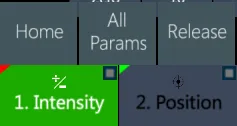
Home (assign home value)
All Params (selection in editor)
Release (release from editor)
Params Quick Actions, referred to the specific parameter on the encoder or extra wheel, are:
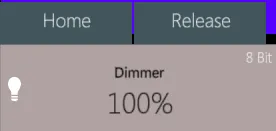
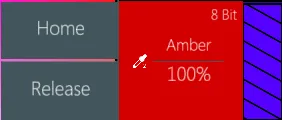
Home (assign home value)
Release (release from editor)
7.2.1 Intensity
Intensity bank has parameters like Dimmer, Shutter and Strobe.
The dimmer level can be set either with the editor keys and wheels, and through the smart screen by using the virtual sliders and the predefined incremental steps.
The strobe and shutter level, mode and frequency can be set in the smart screen with the macros showing the selected fixtures’ properties.
Smart Screen - Intensity Bank
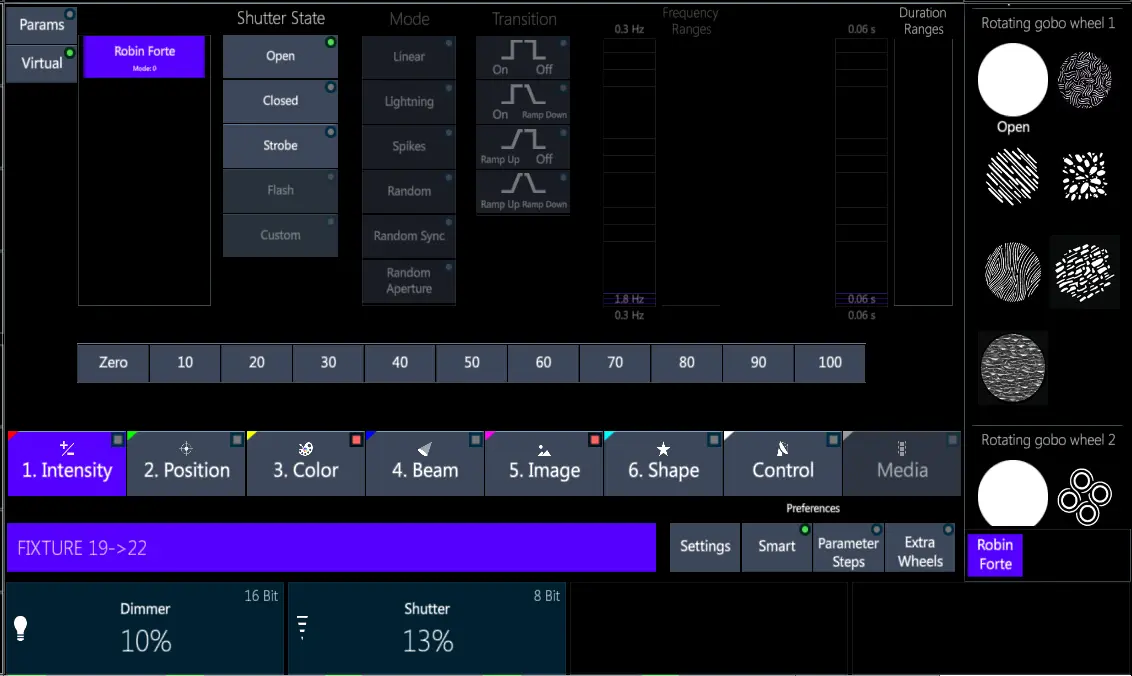
If the selected shutter / strobe parameter’s step has the possibility of a linear control of the rate, the virtual slider that controls the transition timing in Hz will be enabled.
7.2.2 Position
Position bank has parameters like Pan and Tilt.
The fixtures’ position can be set either with the editor keys, wheels, and trackball, and through the smart screen by using the virtual sliders and the position picker.
Smart Screen - Position Bank
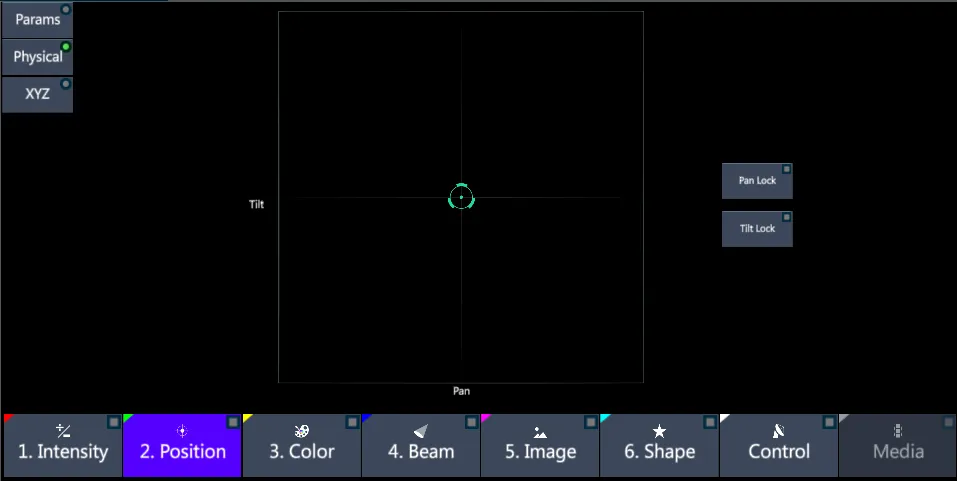
The position is calculated at the same time on Pan/Tilt values and on virtual XYZ values, based on the fixture’s calibration on the stage.
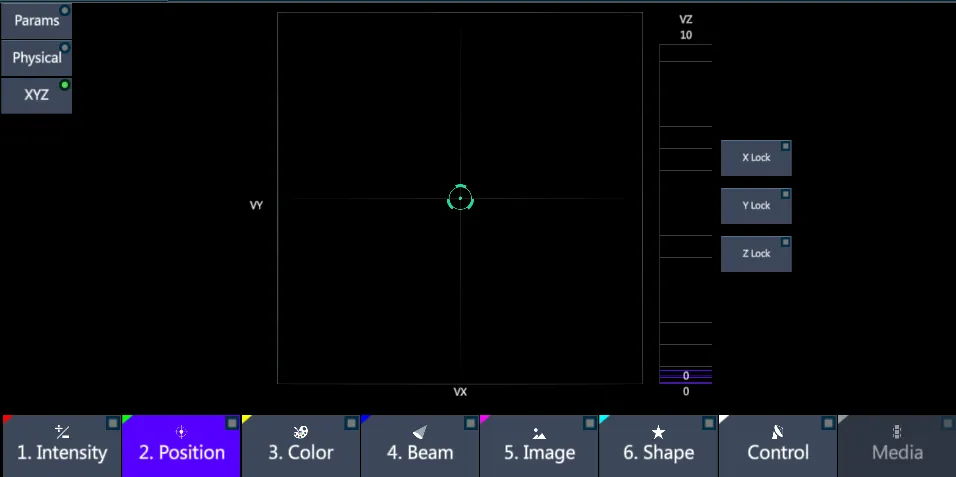
Independently from the fixture’s pan and tilt range, the virtual XYZ coordinates allow easy interchangeable operations between different kinds of fixtures.
In case of exchange with a fixture using a different pan and tilt range, the XYZ values will automatically recover the positions.
Position Lock functions allow to temporarily lock a movement direction to gain a more precise control of the unlocked ones.
This may be done on the panel by using the X-Lock, Y-Lock and Z-Lock buttons, which blink while enabled (when using the physical parameters, they will respectively lock Pan and Tilt).
This may also be done on the Smart Screen position pickers.
The Physical picker shows the Pan and Tilt Lock keys, while the Virtual picker shows the X,Y,Z Lock keys.
7.2.3 Color
Color bank has parameters like Color Mix (RGB, CMY, RGBW, …) and Color Wheels.
The color level can be set either with the editor keys and wheels, and through the smart screen by using the virtual sliders in “Params” screen, the color picker in “Virtual” screen, or the color presets.
Smart Screen - Color Bank
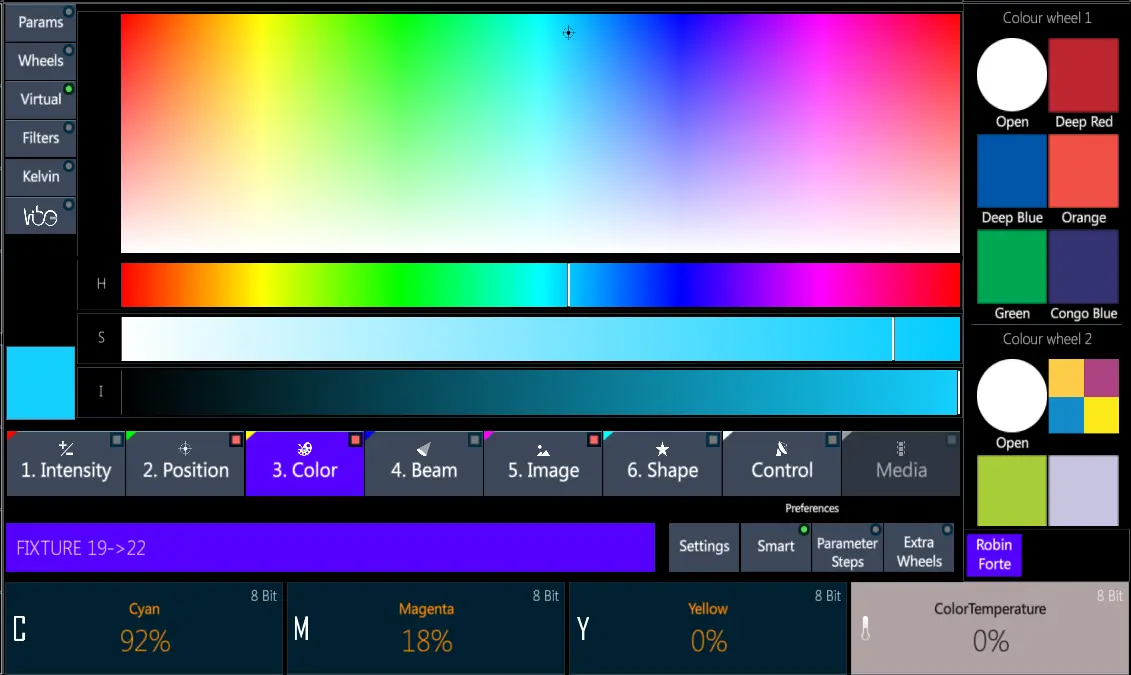
The color mix is calculated at the same time on the color values and on virtual HSI values, based on the fixture’s color mixing system.
Independently from the fixture’s color mixing system, the color picker based on HSI system allows easy interchangeable operations between different kinds of fixtures.
In case of exchange with a fixture using a different color mixing system, the virtual HSI values will automatically recover the fixture’s colors.
The color wheels are visualized in the interactive wheel picker on the right and can be selected with a touch. The selection opens the image picker to get complete control on the wheels’ features.
The color mix can also be set by using the predefined preset combinations and Vibe’s smart features.
Filters Picker
Color bank has a Lee and an Other filters section to assign colors based on the most used brands of gel filters.
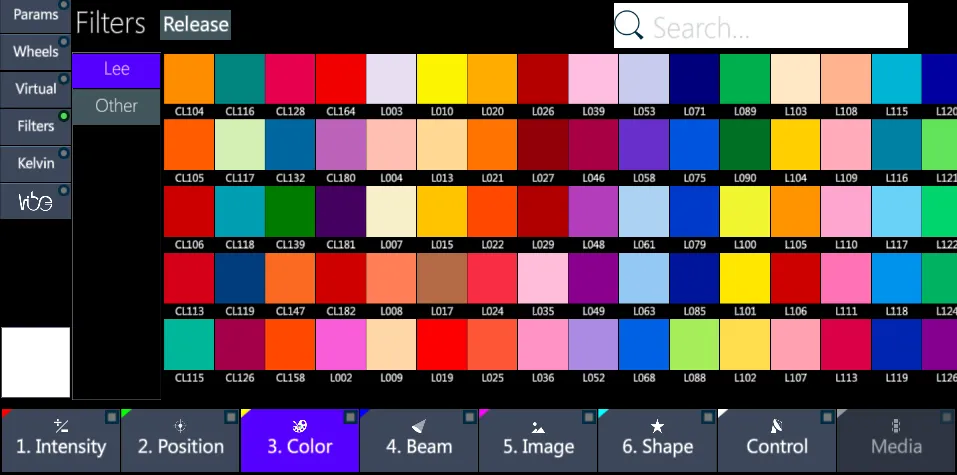
Use the search field to find a specific filter by its numeric code.
Kelvin Picker
Color bank has a Kelvin picker for a fast adjust of any color temperature between 1000K and 20000K, linearly or by incremental steps.
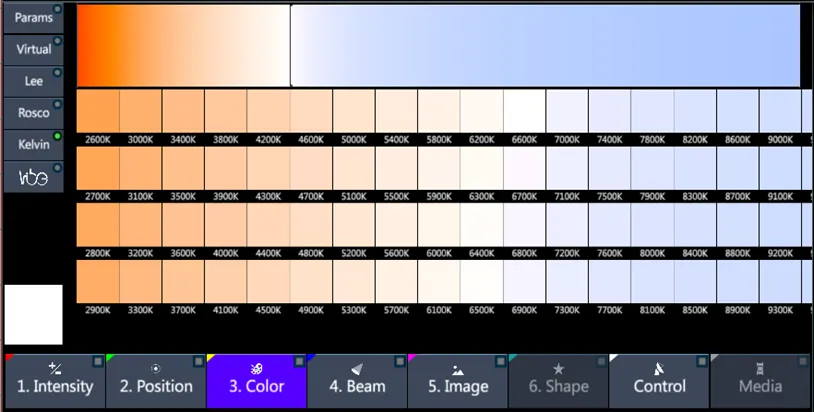
This feature is recommended for working in television studios and photography environments.
Vibe Mood Picker
Color bank has a Vibe mood picker for a fast reproduction of a color taken from a picture.
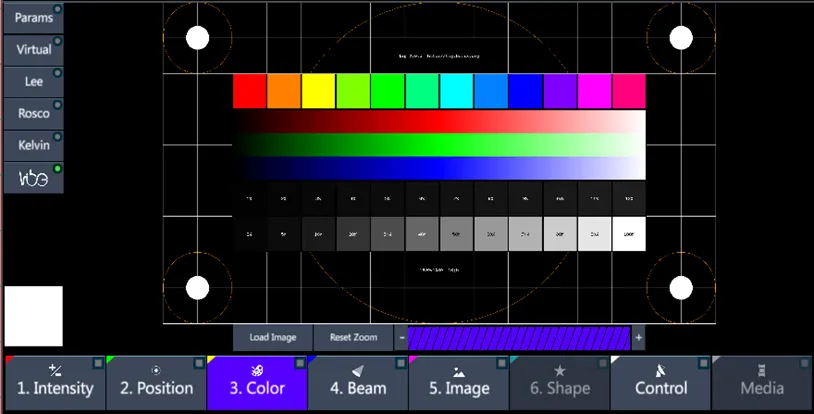
This feature is recommended if working with assigned color palettes, for example in cinema or theater shows, to create color libraries directly from the scene’s and costumes’ pictures.
To get a color from an image:
Load an image file to the Vibe mood picker
Zoom the section of the target color
Select the color to assign to the fixture selection
👉 The system provides an inbuilt database of 10 default images that may be used to check the Vibe Mood Picker and create Color Libraries based on the images’ tones.
7.2.4 Beam
Beam bank has parameters like Focus, Zoom, Frost and Prism.
The beam parameters can be set either with the editor keys and wheels, and through the smart screen by using the virtual sliders and the beam picker.
Smart Screen - Beam Bank
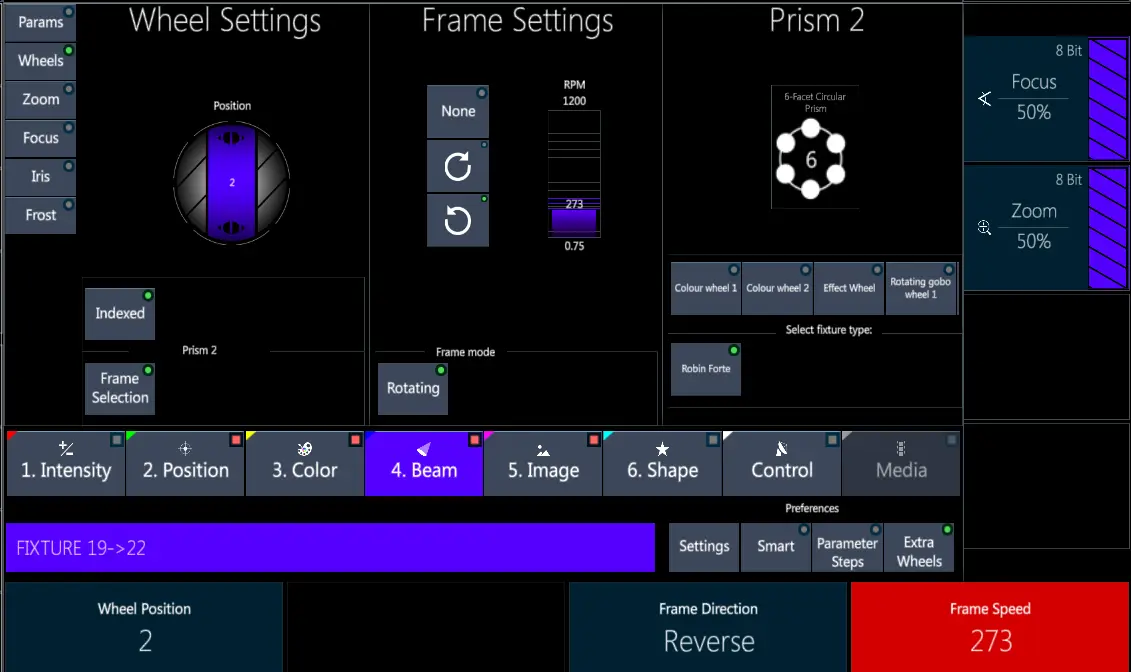
The beam picker automatically enables the features available on the selected fixtures, offering an intuitive control system to set the mode, speed and type of transition related to the controlled parameter.
The prisms are visualized in the interactive wheel picker on the right and can be selected with a touch. The selection opens the wheel picker to get complete control on the prism wheels’ features.
7.2.5 Image
Image bank has parameters like Gobo and Effect wheel.
The image parameters can be set either with the editor keys and wheels, and through the smart screen by using the virtual sliders and the image picker.
Smart Screen - Image Bank
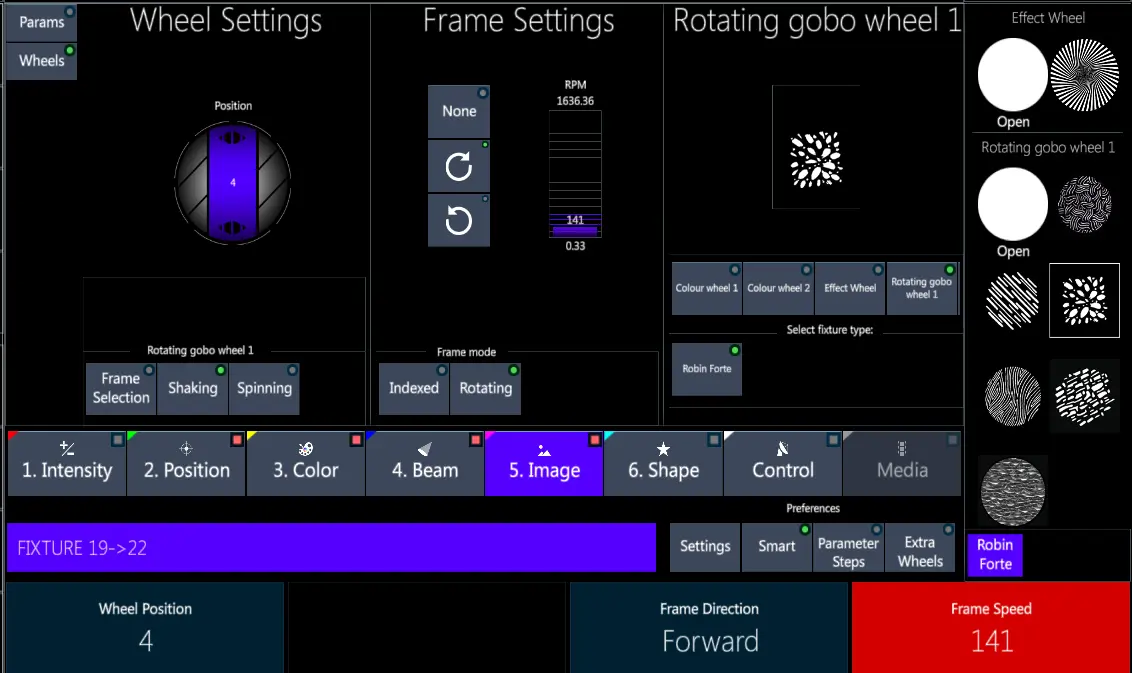
The gobo wheels are visualized in the interactive wheel picker on the right and can be selected with a touch. The selection opens the image picker to get complete control on the wheels’ features.
The image picker can be also accessed by pressing the Virtual button on image bank’s screen.
On the image picker’s right side, it is possible to visualize and select each fixture’s wheel, on the left side can be set the indexing and rotation speed of the whole wheel or the single frame.
The interactive wheel picker shows all the graphic frames related to the selected wheel to allow fast interchange operations.
7.2.6 Shape
Shape bank has parameters like Blade movement and rotation.
The blades’ depth and angle can be set either with the editor keys and wheels, and through the smart screen by using the virtual sliders and the blade picker.
Smart Screen - Shape Bank
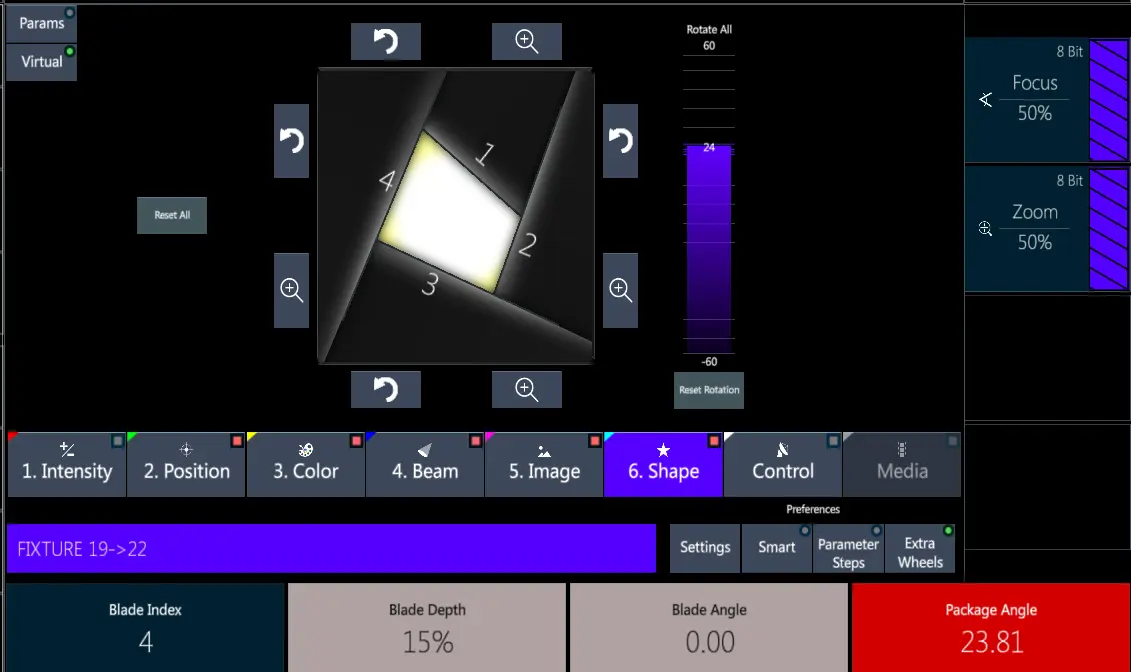
The blade picker features a smart graphic control of the blade, independently from the fixture’s blade system.
Each single blade can be moved, angled, and individually reset, the blade system can be rotated all together, and the reset options permit to reset the whole system or just the rotation parameter.
7.2.7 Wheel Picker
Wheel Picker is used to control any kind of wheel, such as Color, Prism, Gobo and Animation. The values will be stored into libraries, scenes and cues according to the parameter’s bank.
Smart Screen - Wheel Picker
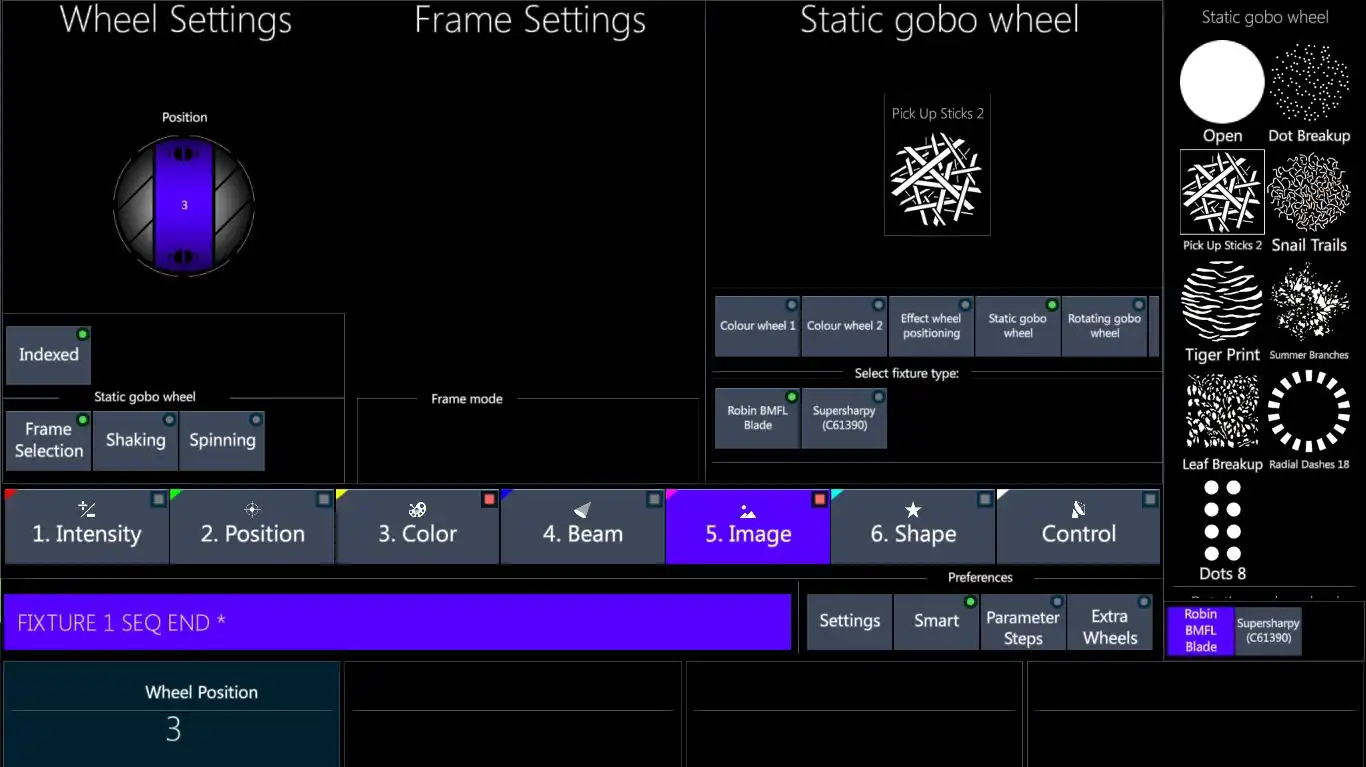
The wheels adjusted with the wheel picker will reflect into values assigned to the wheel’s parameters, usually the wheel’s positioning and rotation and the wheel’s frame selection, index and rotation.
Any wheel of the fixtures can be controlled through the wheel picker exactly in the same way, depending on the available possibilities, by using the Smart Screen’s “Smart” visualization mode to visualize and select the frames’ icons directly on the right side column.
7.2.8 Control
Control bank has parameters related to the fixture’s functions, like Lamp on/off and Reset.
Smart Screen - Control Bank
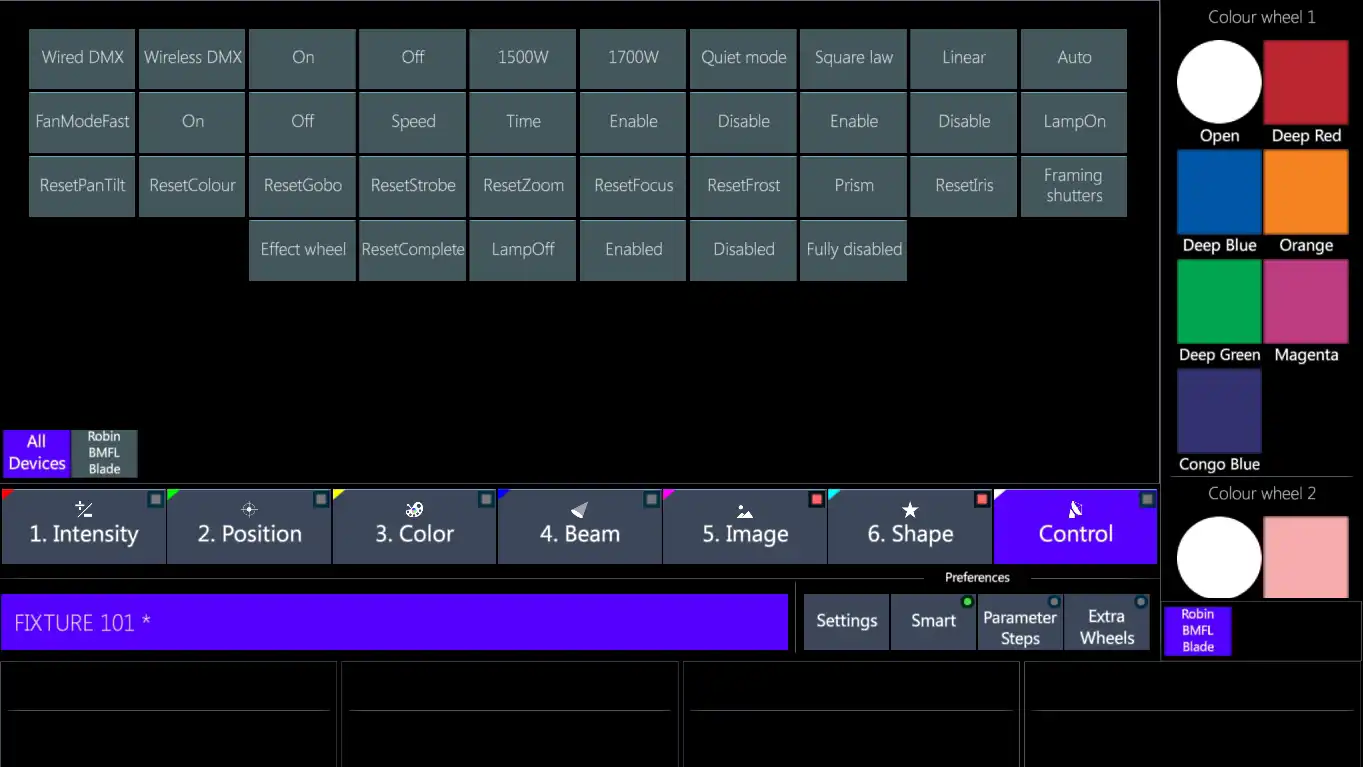
The control bank is a special bank as its parameters are not stored in cues. Instead it sends “real time” messages to fixtures control functions.
7.2.9 Media
Media Bank is the picker designed for an intuitive Media Server programming, to handle media contents in a smart and easy way.
In order to see the content in this bank, users will need to create Media Server fixtures such as Green Hippo’s Hippotizer or Arkaos.
All virtual controls are also mapped to the physical wheels for easy use.
The Media Bank has 5 types of pickers:
Media
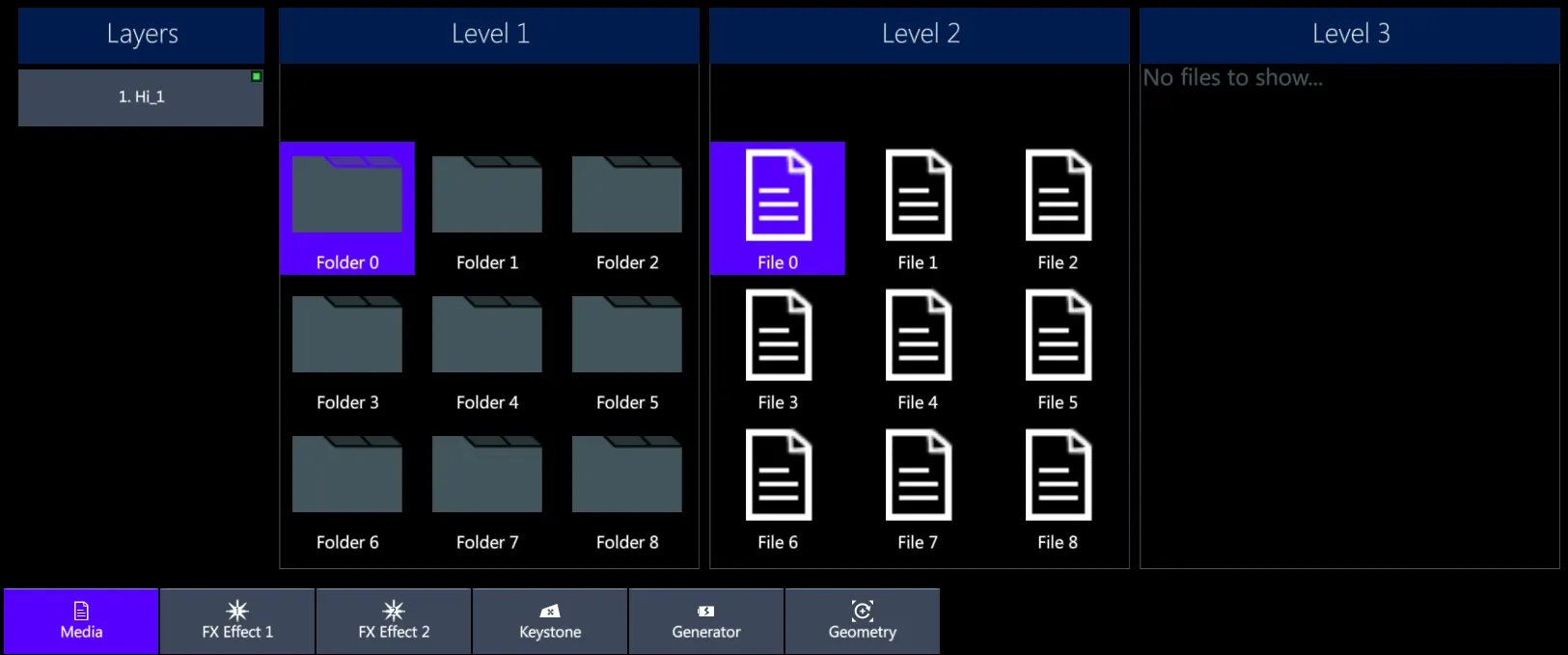
This picker includes a quick way to trigger media files from the media server. It shows all the folders and files inside the server and lets the user decide which one to play.
By default all the folders and subfolders are visible, and once synchronizing the data with the media server through CITP the file’s thumbnails will be shown.
FX (Effect)
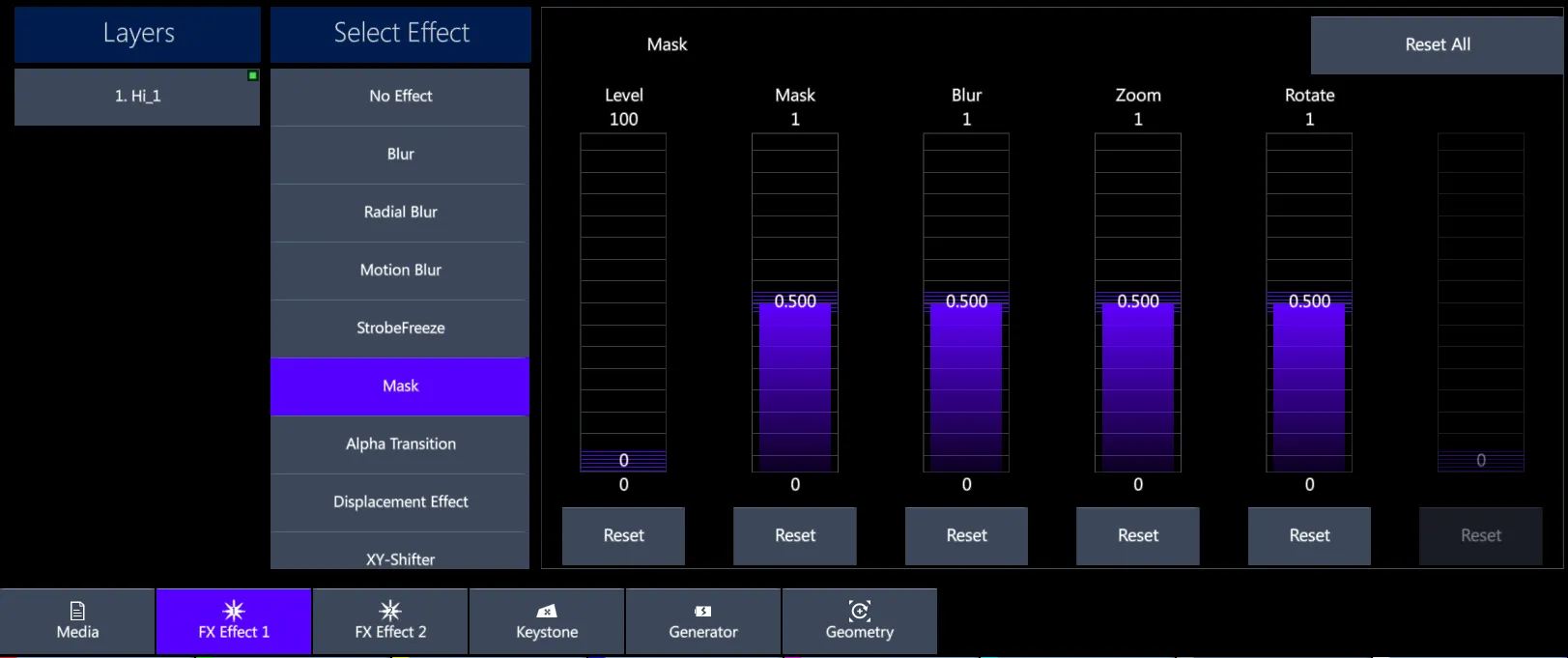
This picker includes the effects available on the media server.
There are media servers with more than 1 effect engine (layer) and for each effect there will be a numbered FX Bank button.
The FX Bank includes a list of effects that are possible to trigger on the server and a list of parameters to control the effect.
The parameters will be dynamically changed according to the selected effect.
Keystone
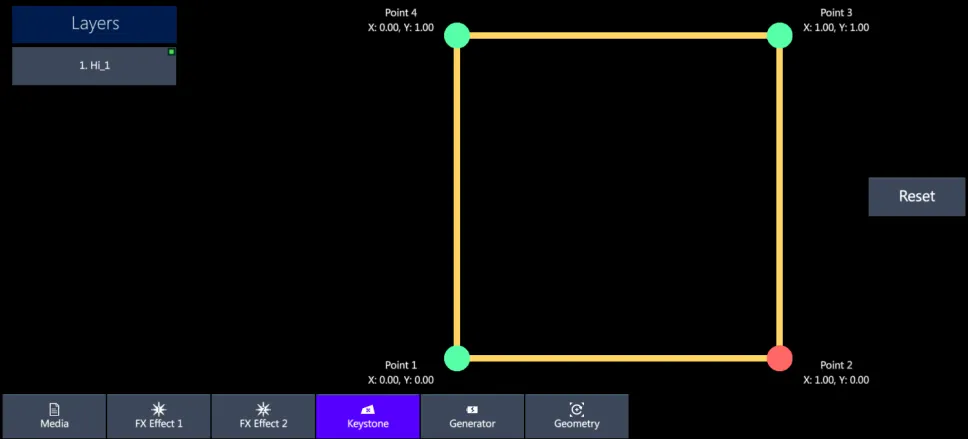
This picker includes a graphic interface to control the keystoning of the server.
There are 4 points available for movement in order to control the position of each corner of the keystone control.
The selected point that is assigned to the physical wheels is marked in red.
Generator
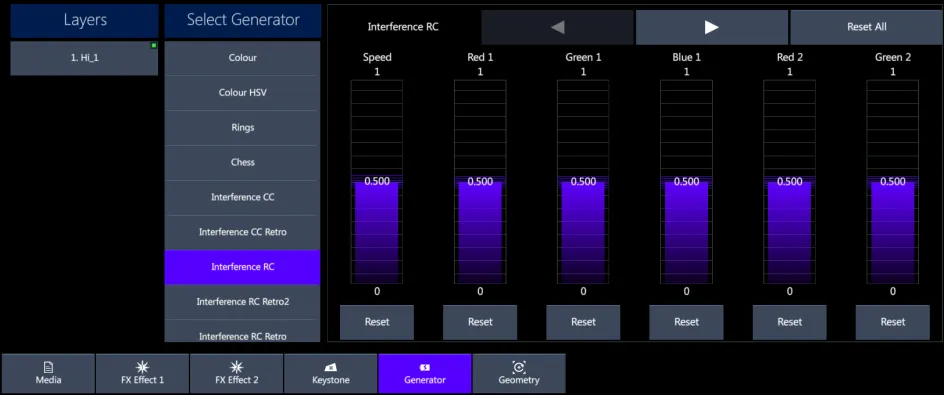
This picker is specifically made for Hippotizer. On this bank, users can control the picture that is sent from the server’s layer on the Generator engine.
The bank acts the same as the Media FX bank by selecting the Generator from the Generators list and then moving the Generator’s parameters accordingly.
Geometry
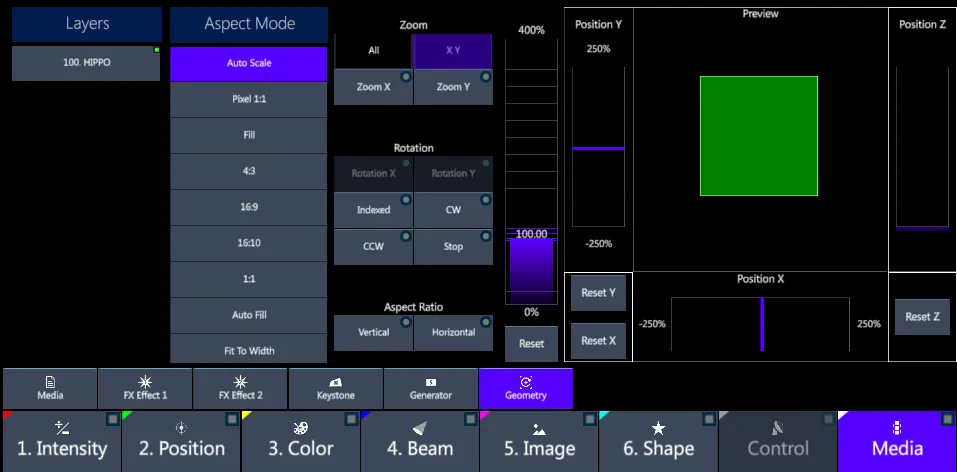
This picker includes an interface to control most of the geometric functions of the media server.
There are options to control:
Aspect Mode of the layer
Zoom
Rotation, Indexed or Rotating with speed control
Aspect Ratio
Positioning, both X and Y
In addition there is a graphic preview to show the approximate result of the geometric parameters.
7.2.10 Settings
The main Smart screen settings, shown on the first level, refer to the content visualized on the right side columns.
The right side columns may be set in the following modes:
Smart - show the wheel’s frames of the selected fixtures
Param Steps - show the stape of the active parameter
Extra Wheels - show the parameters assigned to the extra wheels
👉 While working on banks like Position, Image and Shape, it is very often needed to adjust the focus and zoom of the fixtures. Therefore it may be used the Extra Wheels option on the Smart screen to get these parameters directly available on the extra wheels, with no need to switch to the Beam bank to control them.
Smart Screen’s Settings are accessed by tapping the {Settings} key.
The options are divided in 3 menus:
Format
Resolution
View
The {Home} key returns menus to the upper level.
Format - Sets the view format for wheel displays.
Percent
Decimal
Text
Text + Percent
Source PB
Resolution - Sets the wheels’ and the virtual pickers’ control resolution.
👉 This may also be set by toggling the [Res] key over the trackball.
8 bit - Blue on [Res] Key
10 bit - Green on [Res] key
12 bit - Red on [Res] key
16 bit - Yellow on [Res] key
24 bit - Magenta on [Res] key
View - Sets the behavior of the smart screen views, divided in Display Mode and Echoline Mode.
Display Mode
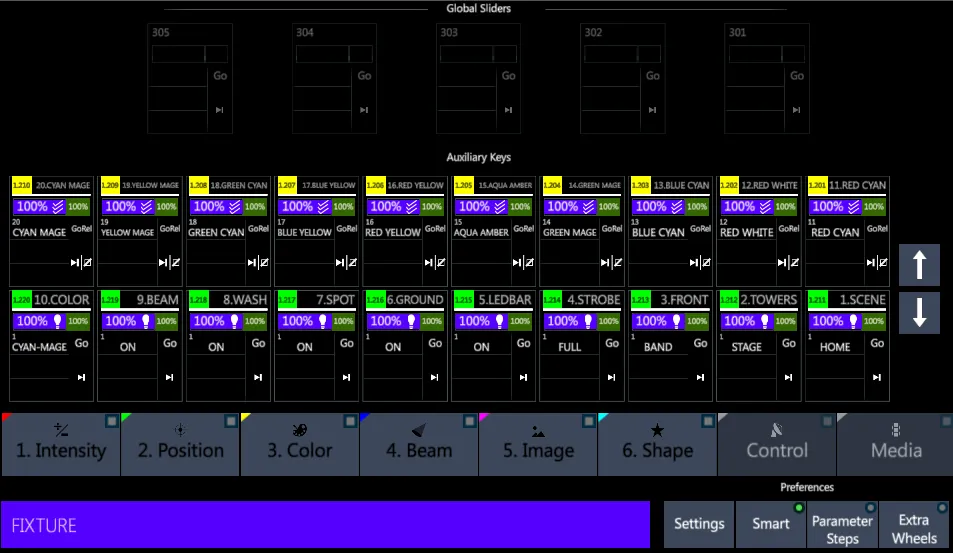
- Auto - Shows programming display when there are fixtures in the editor, and shows the controller displays for Aux Qkeys and Global Sliders when the editor is cleared.
- Programming - Maintains the programming display even with the editor released.
- Playbacks - Maintains the playback controller display even with fixtures in the editor.Echoline Mode

- Fixture Selection - The line shows the current editor's fixture selection.
- Syntax - The line shows the current syntax, like the main screen's toolbar.Smart Screen’s Preferences are accessed by tapping the {Smart} {Param Steps} and {Extra Wheels} keys near the {Settings} key.
The preferences affect the visualization display in the right side column of the smart screen:
Smart - All wheels for the selected fixture are shown in the interactive wheel picker area.
Parameter Steps - Pressing a parameter wheel or tapping the wheel display above it will display a picker list of all feature steps for the selected fixture.
Extra Wheels - Displays wheel information for the additional context sensitive encoder wheels.
7.3 Features
7.3.1 Clear
To clear the last command or key pressed from the Command Line
- Press [CE] key
To clear the Command Line without releasing the fixture selection and the param values assigned on the editor
- Press [VIBE] + [CLEAR] keys
7.3.2 De-Select
To de-select the current Fixture Selection without releasing the param values assigned on the editor
- Press [FIXTURE] or [FIXTURE] [#] [+ ⟶ -] [#] [VIBE] + [DESEL] keys
To re-select the last Fixture Selection
- Press [.] key
7.3.3 Release
To release all the selected fixtures’ parameters from the Editor
- Press [FIXTURE] or [FIXTURE] [#] [+ ⟶ -] [#] [RELEASE]
To release the entire bank of parameters of the selected fixtures from the Editor
- Press [FIXTURE] or [FIXTURE] [#] [+ ⟶ -] [#] [VIBE] + {Bank} (or tap on the Bank) [RELEASE]
To release a fixture parameter (or the active parameters) of the selected fixtures from the Editor
- Press [FIXTURE] or [FIXTURE] [#] [+ ⟶ -] [#] {BANK} {PARAMETER} [RELEASE]
If a fixture is selected and active (Red), the first press of [RELEASE] releases the parameter and then the second press releases the whole fixture.
7.3.4 Reset
To reset the Editor, releasing all the param values without releasing the fixture selection
- Press [RESET] key
To reset the Editor, releasing both the fixture selection and the param values
- Press [VIBE] + [RESET] keys
7.3.5 Home
When a parameter is not in use, meaning it is not in the Editor, neither triggered from any Playback, the values used by Vibe to tell where the fixture parameters should be set can be based on the fixture’s home values or on the last value assigned.
Vibe has two options to set uncontrolled parameters’ values, that can be set in the System Settings popup in the {Editing Properties} tab under the Default Stage Values header:
{Use Home values} sets the uncontrolled parameters to their Home Value
{Maintain Last Value} leaves the uncontrolled parameters to Maintain the Last Value they were at before being released
All the devices have default home values for parameters based on the manufacturer’s DMX chart.
Selected fixtures or parameters may be sent to their defaults using the [HOME] key.
Home - Sets parameter values to home values as defined by the manufacturer or to custom values defined by the user Home Scene.
The [HOME] button brings the fixture, bank or parameter home value in the Editor.
To Home selected fixtures in the Editor
- Press [FIXTURE] or [FIXTURE] [#] [+ ⟶ -] [#] [HOME]
To Home the entire bank of parameters of the selected fixtures in the Editor
- Press [FIXTURE] or [FIXTURE] [#] [+ ⟶ -] [#] [VIBE] + {BANK} (or tap on the Bank) [HOME]
To Home a fixture parameter (or the active parameters) of the selected fixtures in the Editor
- Press [FIXTURE] or [FIXTURE] [#] [+ ⟶ -] [#] {BANK} {PARAMETER} [HOME]
If a fixture is selected and active (Red), the first press of [HOME] homes the parameter and then the second press homes the whole fixture.
7.3.6 Highlight
Highlight is used to help identify the positions of fixtures, so they may be edited more easily.
Highlight Mode affects parameters and banks in the following way:
Dimmer - Full
Other Intensity parameters - home values and masked
Position - unchanged and editable
Color - home values and masked
Beam - home values and masked
Image - home values and masked
Shape - home values and masked
To Highlight Fixtures or Groups:
Select fixtures using keypad or using Groups.
Press [H.LIGHT] - The key will flash in red to indicate the mode is active.
All the Fixture selection will be set as specified above.
Press [NEXT] - The first fixture will remain “highlighted” and all other fixtures will return to their editor or stage values.
Adjust Pan/Tilt as required and press [NEXT] to move to the next fixture.
Continue through the fixture selection using [NEXT] [PREV] until all fixtures are focused.
Press [H.LIGHT] again to turn off Highlight Mode. The red light will go out and fixtures will return to their current editor or stage values.
Highlight may be entered before a selection is made. Press [ENTER] to Highlight the selection.
To swap new fixtures into Highlight:
- Select new fixtures or Groups and press [ENTER] while still in Highlight Mode - the Highlight selection will be swapped.
Until [NEXT] [PREV] is pressed Groups will be appended to make up a larger Highlight selection.
Highlight may be customized when the default home values are too generic.
👉 Frequently users tighten the zoom or use a closer iris value as default to better focus the center of the beam.
7.3.7 Lowlight
Lowlight is used when many fixtures are lit up and therefore Highlight is not helpful.
Lowlight Mode affects parameters and banks in the following way:
Dimmer - 30% all fixtures except active fixture which will be at 100%
Other Intensity parameters - home values and masked.
Position - unchanged and editable
Color - home values and masked
Beam - home values and masked
Image - home values and masked
Shape - home values and masked Unlike Highlight, Lowlight maintains a value of 30% for dimmers while active.
To Lowlight Fixtures or Groups:
Select fixtures using the keypad or using Groups.
Press [L.LIGHT] - The key will flash in red to indicate the mode is active.
Press [NEXT] - The first fixture will go to a dimmer value of 100% and all other fixtures dimmer values will remain at 30%. Other parameters will return to their editor or stage values.
Adjust Pan/Tilt as required and press [NEXT] to move to the next fixture.
Continue through the fixture selection using [NEXT] [PREV] until all fixtures are focused.
Press [L.LIGHT] again to turn off Lowlight Mode. The red light will go out and fixtures will return to their current editor or stage values.
Lowlight may be entered before a selection is made.
Press [ENTER] to Lowlight the selection.
To swap new fixtures into Lowlight:
- Select new fixtures or Groups and press [ENTER] while still in Lowlight Mode - the Lowlight selection will be swapped.
Until [NEXT] [PREV] is pressed Groups will be appended to make up a larger Lowlight selection.
Lowlight may be customized when the default home values are are too generic.
👉 Frequently users set the Lowlight dimmer to Zero instead of the default 30% to create a solo effect.
7.3.8 Rem Dim
Remainder Dim is an Editor Tool commonly used in theater environments but can be useful in many other situations.
{REM DIM} Toggles all dimmer values to 0 except those that are selected.
If no value is given in the editor, the selected fixtures will maintain their current values.
Find {REM DIM} key on the toolbar when there’s a Fixture Selection active.
While in {REM DIM} is ON, [Next] / [Prev] will swap the Rem Dim fixture forwards or backwards.
If a selection of multiple fixtures is made followed by {REM DIM} all unselected fixtures will go to 0%. The selected fixtures will not be changed or entered into the editor.
If a selection of multiple fixtures is made, [Next] / [Prev] will force all but the first fixture in the selection to 0. The next press of [Next] / [Prev] will force the first fixture to 0 and release the next fixture’s dimmer. Fixtures in the selection will continue to swap from 0 to release with each press of [Next] / [Prev].
Pressing REM DIM again toggles the feature off and restores the stage look.
Cues may be stored with {REM DIM} ON and the dimmers forced to 0% by Rem Dim will not be stored.
Once stored, {REM DIM} is turned off.
7.3.9 Undo
Undo button directly rolls back the last actions.
Every parameter programmed in the editor can come back to its previous status by pressing the UNDO button.
Pressing Undo button multiple times will restore step by step the last actions.
Undo function can be used to recover the editor status after a Shift + Reset command, and to restore objects that have been stored, deleted, or updated, such as groups, libraries, qlists, cues and scenes.
Undo button works also with Home and High/Lowlight actions.
Undo History
Settings ⟶ Undo opens the Undo/Redo list to review and restore the last actions.
Undo History
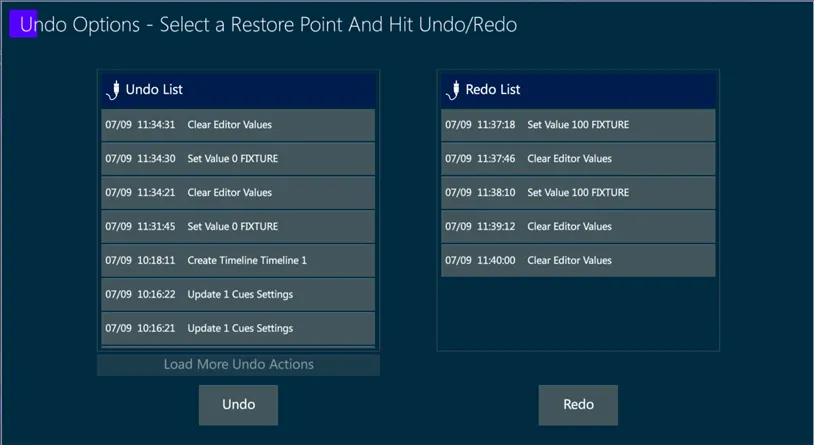
To Undo more operations at a time, access the Undo history with the sequence [Vibe] + [Settings], [Undo]
In the Undo popup’s left column are listed all the undoable actions, and in case an undo command has been done, the list on the right shows the redo able actions.
Each action reports the date and time when it has been done.
Select one or more actions, than press undo or redo to come back to the desired status.
The popup does not close until the apply or restore buttons are pressed.
7.3.10 Fan
Fan is used to apply a distribution of values to the Fixture Selection.
Fan of the selected fixtures’ parameters can be done either through the keypad syntax or by using the [Fan] key and Smart Screen’s interface.

To enter the Fan Mode
Select the range of fixtures to be fanned.
Press [FAN] to enter Fan Mode. - The key will flash in red to indicate the mode is active.
Select a Curve from the Fan Mode picker on the Smart Screen’s right side.
Turn the encoder wheel of the parameter. - The param’s values will be set fanned proportionally to the curve applied the order of selection.
Toggle [FAN] OR Select a different parameter to turn Fan mode off.
Frequently used Fan curves:
{Fade In} / = lowest to highest
{Fade Out} = highest to lowest
{Diagonal} -/- = Standard PAN Fan
{Saw Tooth} / = Mirror lowest on ends to highest in middle
{Mirror} / = Highest on ends to lowest in middle
Curves can be freely changes while in Fan Mode to check the different results.
Any Curve created in the Curves Editor may be applied to Fan.
The Fixture Selection can be splitted to get fanned in Blocks of and Sub Blocks:
Select the range of fixtures to be fanned.
Press [FAN].
Select a Curve from the Fan Mode.
Select Blocks of {#}
Select Sub Blocks {#}
Turn the encoder wheel of the parameter requiring fanning.
Toggle [FAN] to turn off Fan Mode.
Examples of Blocks and Sub Blocks:
- {Fade In} - Blocks of 1 and no Sub Block

- {Fade In} - Blocks of 4 no Sub Blocks

- {Fade In} - Blocks of 6, Sub Blocks of 2

- {Saw Tooth} - (Low-High Mirror) Blocks of 12, Sub Blocks 2

- Moving Light Fixture with {Fade In} Dimmer and Color Fan, and {Diagonal} Pan Fan

Fixture Groups may also be used as Blocks.
To Fan Blocks By Groups:
Select the Groups
Press [FAN].
Tap {Blocks By Group} under the Fan Mode picker.
Use any of the above methods to fan parameters by Group.
7.3.11 Copy / Paste
[COPY] and [PASTE] are used to make copies of any object, such as Groups, Libraries, Scenes, Cues and Qlists, and store them in the desired positions.
The syntax to copy and paste an object is:
{Object} [COPY] {Target} [PASTE]
👉 [COPY] and [PASTE] keyboard syntax can be also used to copy and paste the selected (Red) params of a fixture to another.
When something is in Copy the [COPY] key will flash in red to indicate there is a copied content.
When a Paste command applies the content to the target, the data is kept on the Copy key to allow making other copies.
Toggle [COPY] or [RESET] the Editor to remove the content from the copy feature.
Copy and Paste param values to Fixtures
{Fixture} {Param Selection} or {GRAB ALL} [COPY] {Fixture} [PASTE]
Copy and Paste a Bank of param values to Fixtures
{Fixture} {Bank Selection} [COPY] {Fixture} {Param Selection} [PASTE]
Copy and Paste param values to Groups
[Group] {Param Selection} or {GRAB ALL} [COPY] [Group] {Param Selection} [PASTE]
Copy and Paste param values from Cues
[Qlist] [#] [Cue] [#] [Fixture] [#] [COPY] [Fixture] [#] [PASTE]
Load param values from Cues to Editor
[Qlist] [#] [Cue] [#] [Fixture] [#] [LOAD]
7.3.12 Move
[MOVE] is used to change position of any object, such as Groups, Libraries, Scenes, Cues and Qlists.
The syntax to move an object is:
[MOVE] {Object} {Target}
[MOVE] can be also used to re-position Playback controllers without changing their content and settings.
The syntax to Move a controller is:
[MOVE] {Controller} {Target Controller}
7.3.13 Grab
Grab is a powerful tool for selecting fixtures that meet a number of conditions.
By default [GRAB] selects all fixtures with intensity or virtual intensity values above Zero.
Pressing [GRAB] without a selection opens a popup on the Smart Screen with the following options.

{Filters}
{Stage} - Select anything that is live on the stage and meets the conditions below.
{Editor} - Select anything that is in the Editor and meets the conditions below.
{Master Controller} (Playback) - Selects only fixtures on the Master Controller that meet the conditions.
{Conditions}
{All Fixtures} - Selects all fixtures that have any changes via the editor.
{Active} - Fixture has intensity value over zero.
{Invisible} - Recorded “hard” parameter values for fixtures that do NOT have an intensity value over zero.
{Inactive} - Fixtures that have NO recorded values.
{Parameter Selection}
{All for Selected} Grabs all parameters for selected fixtures (shortcut is [VIBE] + [GRAB])
{Active (ENTER)} Select all “Active” fixtures and enters them into the Editor. (Shortcut is [GRAB] + [ENTER])
{Search & Replace}.
[SET] [GRAB] selects all active fixtures filtered by Set.
Grab Fixtures from a Controller:
Press [GRAB] - Grab Options popup will open.
Press any Slider/Qkey/Aux Qkey controller button - All fixtures that are in the Controller’s active cue and have dimmer levels above Zero (or meet the Grab conditions selected in the popup) will be selected.
👉 Pressing ENTER will put the selection in the EDITOR.
Grab Fixtures in a cue based on a {Library} SK selection:
Press [GRAB], tap a {Library} SK - All fixtures with matching libraries will be selected.
Tap another {Library} SK - The Library will be swapped to the new library.
👉 This is especially useful for quickly swapping colors in cues containing libraries
Select all parameters for a fixture selection:
Select the fixtures
Press [VIBE] + [GRAB]
Select all Parameters with hard and tracked values outputting to the stage:
- Press [GRAB] [ENTER]
Grab an entire bank of parameters of the selected fixtures in the Editor:
- Press [FIXTURE] or [FIXTURE] [#] [+ ⟶ -] [#] [VIBE] + {BANK} (or tap on the Bank) [SHIFT] + [GRAB]
7.4 Live
Vibe has two ways to display parameter data:
Live View - shows editor and playback values as a spreadsheet.
Live Parameter View - shows editor and playback data in a graphic icon-based format.
7.4.1 Live View
The Live view is splitted into 4 different modes:
Live Full: shows the list of fixtures
Live Per Device: shows the list of fixtures, divided per device
Live Full Sub Device: shows the list of fixtures and subfixtures
Live Per Device Sub Device: shows the list of fixtures and subfixtures, divided per device
The preferred Live View mode may be loaded from the Vibe Menu, Program Views, Live submenu.
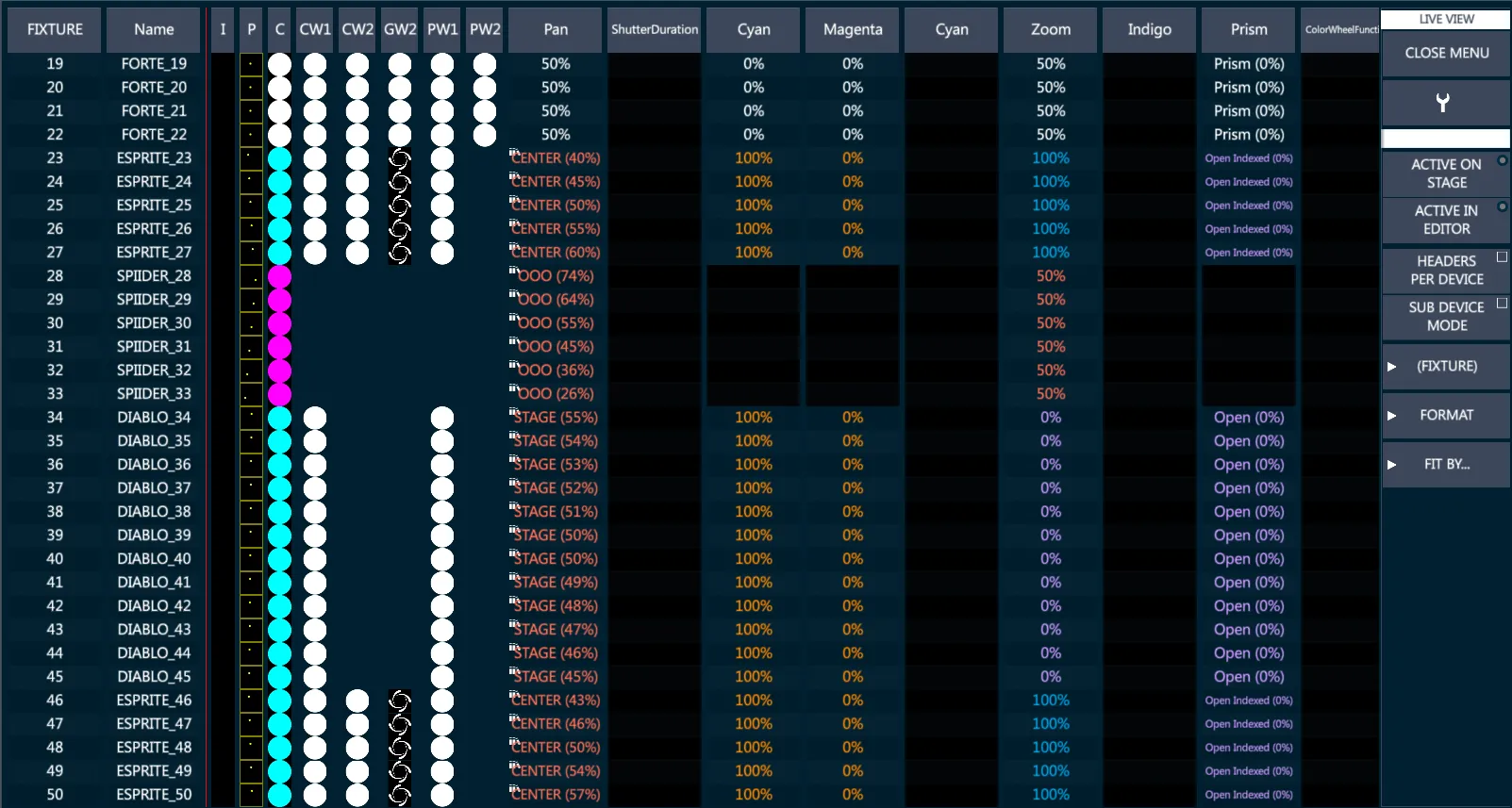
Live View Options are on the Live view’s menu.
Active - Filters the fixtures to display.
if all the options are toggled off, the view shows all the fixtures.
if Active On Stage is on, only parameter columns that are selected in the editor or have values derived from the active stage look are shown. All others are hidden.
if Active In Editor is on, only parameter columns that are selected in the editor are shown. All others are hidden.
Sets - Select which of the fixture sets to display.
Fixture
Channel
Spot
Matrix
Media Server
Custom Sets (if created)
Format - Controls what data is displayed in the cells.
Source PB (the source triggering the value, either it is the editor or a controller)
Value > % (values in percentage)
Value > Decimal (DMX values 0 ⟶ 255 )
Value > Text (Parameter step text)
Value > Text + Percentage (Parameter step text and values in percentage)
Time (Parameter time, if specified in the editor)
Fit By - Opens column width options:
Window
Value
Default
Live View Settings are on a popup accessible by tapping the ![]() Settings icon.
Settings icon.
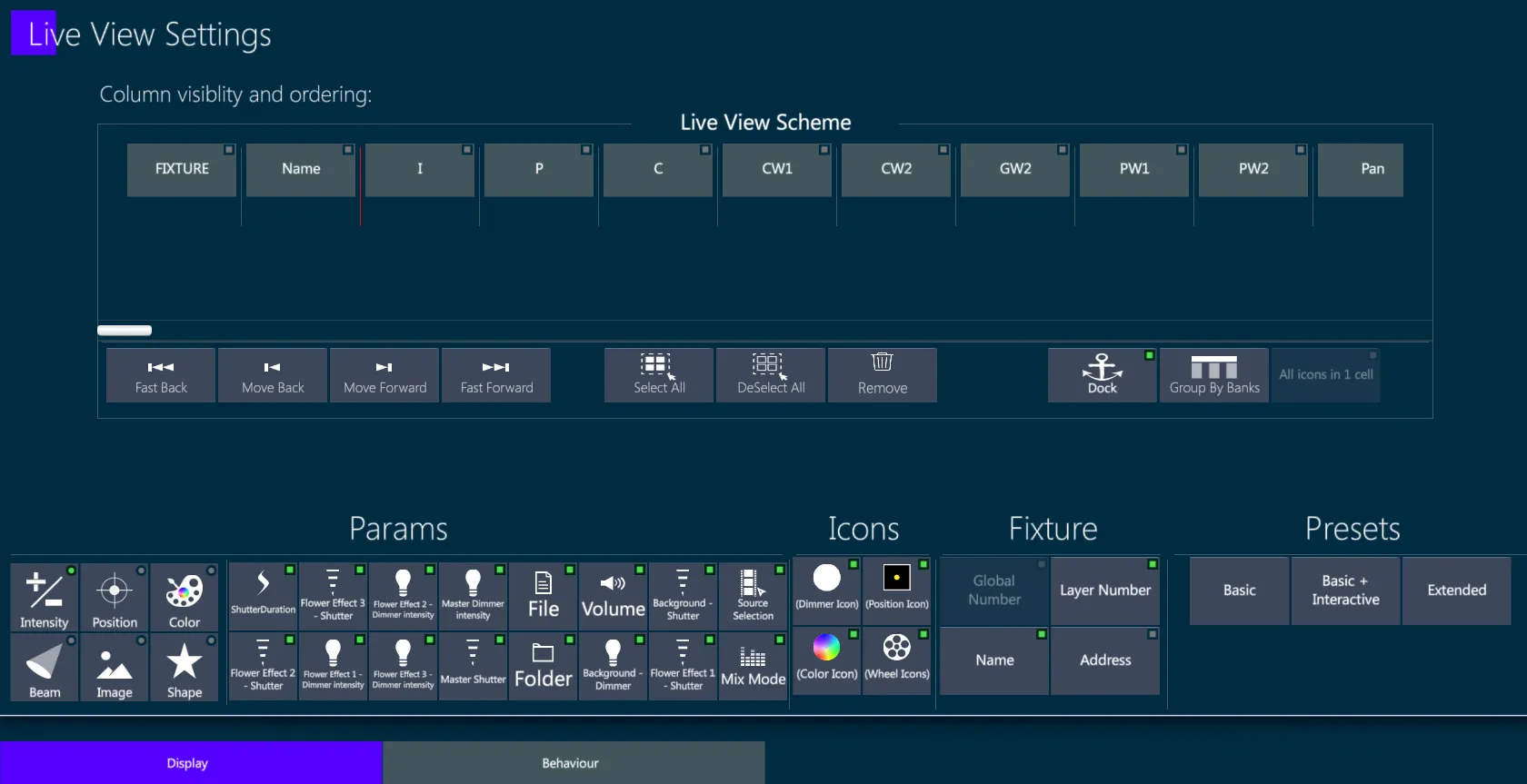
Live View Display tab is to set the cells that are shown and order the columns.
- Live View Scheme - Parameter columns may be freely added, removed, or moved in the grid by selecting and tapping on the move keys.
To Move columns:
Tap a parameter column heading or multiple parameter column headings - the green indicator light will turn on.
Use the {|<} or {>|} keys to move the parameter column forward or backwards.
To Move columns to the first or last position:
Tap a parameter column heading or multiple parameter column headings - the green indicator light will turn on.
Use the {|<<} or {>>|} keys to move the parameter column first position or last position.
To Remove columns:
Tap a parameter column heading or multiple parameter column headings - the green indicator light will turn on.
Tap the {Remove} key.
The Dock option locks the column scroll at the end of the parameter column that is docked. A red line will show on the live display to show the dock position.
The Group By Banks option groups the columns corresponding to the same param bank.
The All icons in 1 cell option is not implemented yet.
- Banks - Columns are added using the icons in the parameter box.
To Add or Remove columns:
Select a bank - All parameters for the bank will appear in the box adjacent to the banks.
Select the parameter or parameters to add to the live display.
👉 Swipe in the the parameter box to browse hidden parameters.
- Tap a parameter that is not already selected in green and it will be added to the end of the column list.
👉 Parameter keys are toggles so if the indicator light is on, touching the parameter will remove it. Tapping again will put it back at the end of the columns. .
- Use the {|<} or {>|} {|<<} or {>>|} to position the column.
- Interactive Icons: - Adds or removes the interactive icons columns.
👉 Interactive Icon keys are toggles so if the indicator light is on, touching an icon key will remove it. Tapping again will put it back at the end of the columns..
General:
Global Fixture Number - Fixture’s hidden unique system number.
Fixture Layer Number - Adds or removes the Fixture Number column.
Fixture Name - Adds or removes the Fixture Name column.
Fixture Address - Adds or removes the Fixture Address column.
👉 Fixture # and Fixture Name are toggles so if the indicator light is on, touching an icon key will remove it. Tapping again will put it back at the end of the columns.
Presets:
Basic - Live view preset that only shows the param columns
Basic + Interactive - Live view preset that shows the param columns, the interactive icons, and the fixture layer name and number
Extended - Live view preset that shows the param columns, the interactive icons, and the fixture layer name, number and address
The Live View Settings popup has two keys to switch On/Off the “Headers Per Device” and the “Sub Device Mode” visualization options.
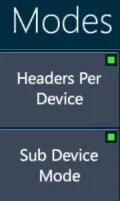
- Headers per Device - Groups the fixtures visualization by devices, showing the device name on each header.
👉 Headers can be collapsed by tapping on the arrow in the header.
- Sub Device Mode - Toggles on/off the visualization of sub-fixtures, available when the device contains sub-devices.
Live View Behavior tab is to set the view’s interactions.
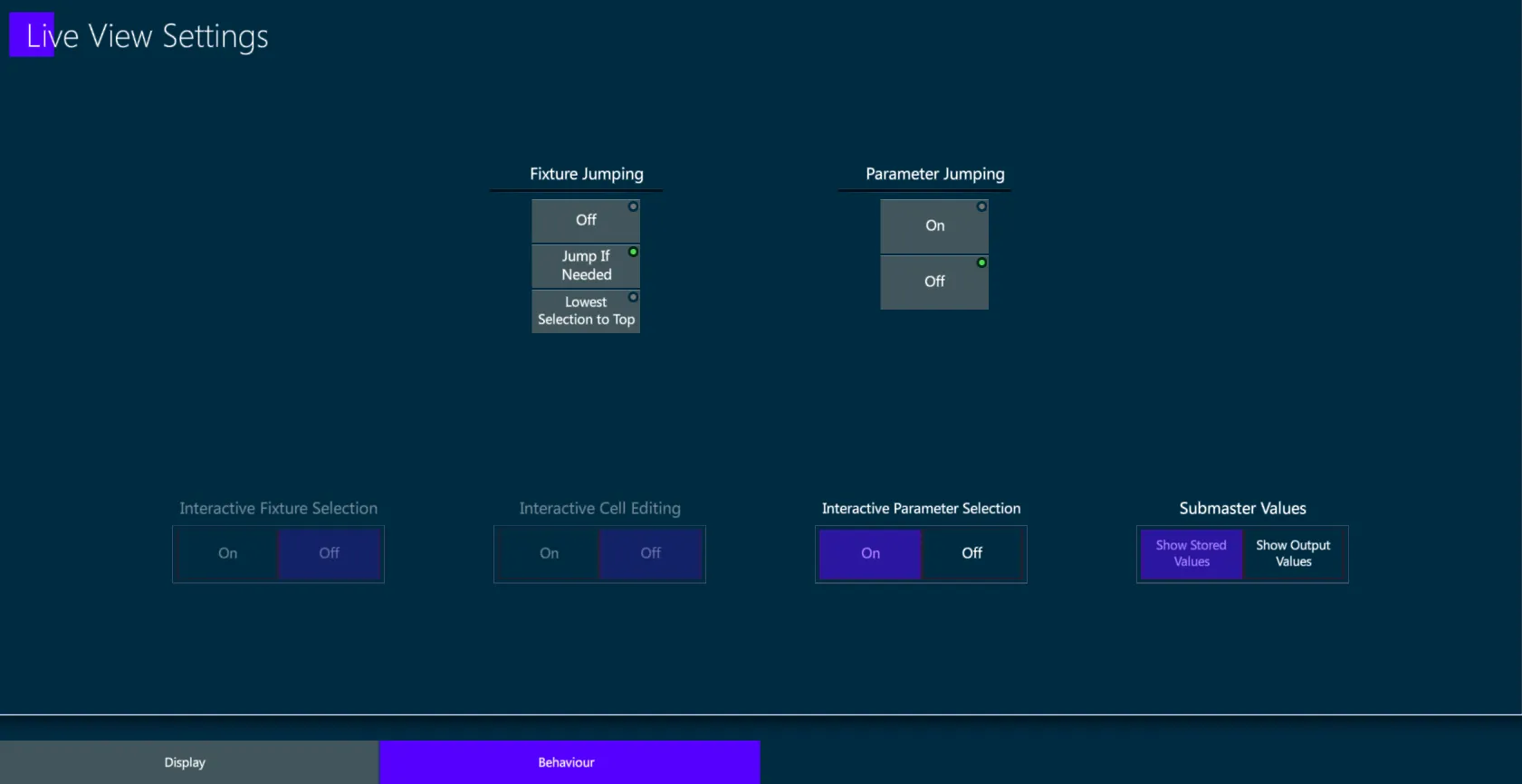
Fixture Jumping:
Off - No jumps.
Jump if needed - Live display pages the display to show the selected fixtures if they are not shown on the current live page.
Lowest Selection to Top - Jumps the lowest fixture number of the selection to the top of the live display.
Parameter Jumping:
- Jumps the parameter’s column and related bank parameters to the first scrollable column (the end of the Dock position).
Interactive Fixture Selection:
- Turns on the ability to make fixture selections from the live display grids.
- Not implemented yet.
Interactive Cell Editing:
- Turns on the ability to directly edit cells in the live display grid.
- Not implemented yet.
Interactive Parameter Selection:
- Enables parameters to be directly selected from the live display headers.
Submaster Values:
Show Stored Values - Dimmer parameters under the control of Group Submasters will continue to show their stored values and the
 Submaster icon will also be shown to indicate when the parameter is inhibited.
Submaster icon will also be shown to indicate when the parameter is inhibited.Show Output Values - When the Submaster is pulled down, the actual dimmer output values will be shown in the live display dimmer column.
7.4.2 Live Parameter View
The Live Parameter View shows values in a table format instead of spreadsheet format.
There are three Live Parameter Modes accessible from the view’s menu:
Live Parameters
Live Banks
Live Fixtures
Mode - Select the options of the fixture / parameter icons displayed.
- Live Parameter - Fixtures are graphically displayed by icons per parameter.

As an evolution to the theatrical consoles concept, parameters other than dimmer are also shown.
Parameters visible in Live Parameter Mode can be filtered by using the Parameter View Settings popup.
To Filter Parameters:
1. Tap the ![]() Settings icon to open the Parameter View Settings popup.
2. Tap parameters on either side to move them from one box to the other.
3. Close the popup with [ENTER] or the
Settings icon to open the Parameter View Settings popup.
2. Tap parameters on either side to move them from one box to the other.
3. Close the popup with [ENTER] or the ![]() Apply icon.
Apply icon.
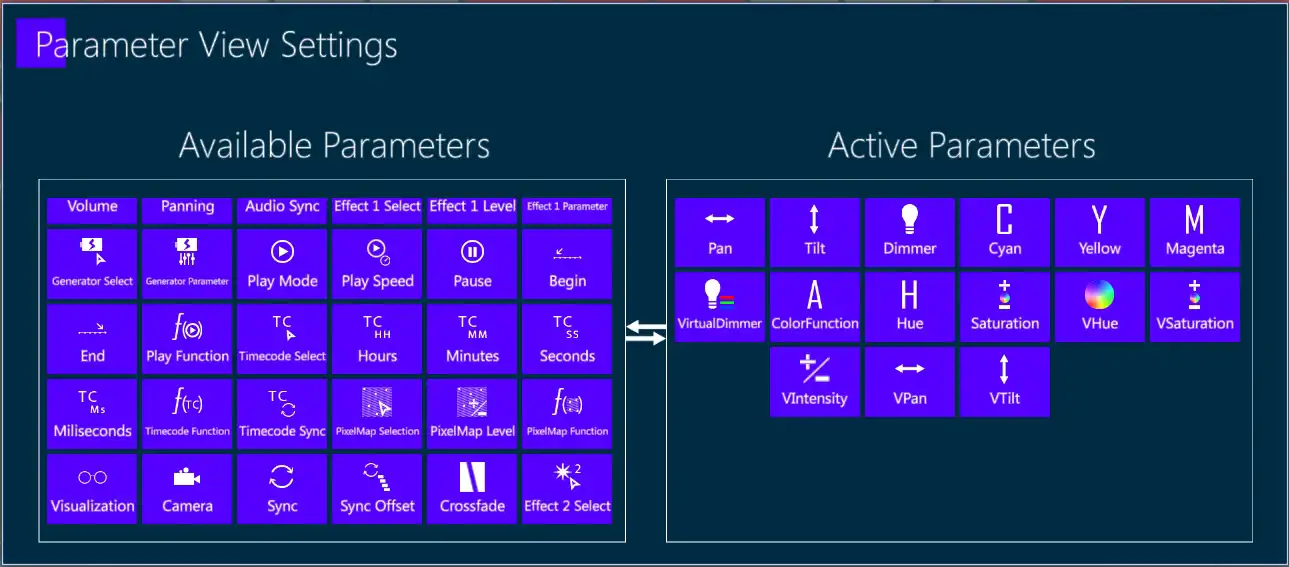
- Live Bank- Fixtures are graphically displayed by icons per bank.

Currently three banks can be graphically viewed:
Intensity - In the form of an illuminated circle.
Position - In the form of a cursor that moves in a black rectangle representing the stage.
Color - In the form of a circular color swatch (Color wheels are not currently supported.)
Live Fixture - Fixtures are graphically displayed by icons per fixture

Intensity, Position, and Color bank icons are merged into a single icon for each fixture.
Active On Stage - Toggle button.
If off, all fixtures are shown.
If on, only fixtures that are selected in the editor or have values derived from the active stage look are shown. All others are hidden.
Sets - Select which of the fixture sets to display.
Fixture
Channel
Spot
Matrix
Media Server
Custom Sets (if created)
Format - Controls what data is displayed in the cells.
Value > % (values in percentage)
Value > Decimal (DMX values 0 ⟶ 255 )
Value > Text (Parameter step text)
Value > Text + Percentage (Parameter step text and values in percentage)